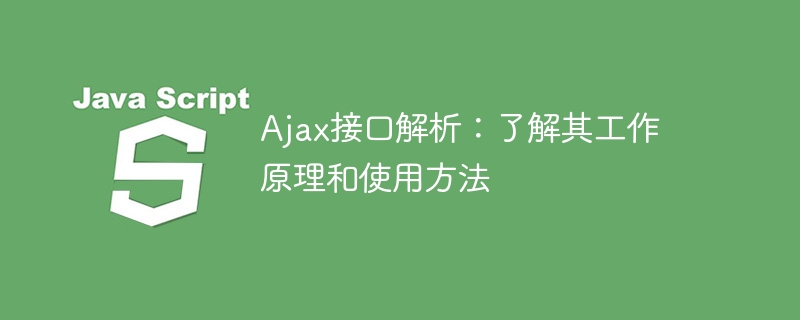Home >Web Front-end >JS Tutorial >Understand how Ajax works and how to use it: Analyze the interface
Understand how Ajax works and how to use it: Analyze the interface
- 王林Original
- 2024-01-17 08:30:17956browse

Ajax interface analysis: To understand its working principle and usage, specific code examples are needed
Introduction:
In Web development, Ajax (Asynchronous JavaScript and XML ) is a common technology that can dynamically update page content through asynchronous data exchange with the server without reloading the entire page. This article will introduce how Ajax works and how to use it, and provide specific code examples.
1. How Ajax works
1.1 XMLHttpRequest object:
The core of Ajax is the XMLHttpRequest object, which is a powerful object provided by the browser for data interaction with the server in the background. .
The way to create an XMLHttpRequest object is as follows:
var xhr = new XMLHttpRequest();
1.2 Send a request:
Through the open() and send() methods of the XMLHttpRequest object, you can send a request to the server and obtain the data returned by the server. .
xhr.open('GET', 'api/data', true); // 发送一个GET请求
xhr.send();1.3 Processing server response:
When the server returns data, the onreadystatechange event of the XMLHttpRequest object will be triggered. We can listen to this event and obtain the data returned by the server through the responseText or responseXML attribute of the XMLHttpRequest object.
xhr.onreadystatechange = function() {
if (xhr.readyState === 4 && xhr.status === 200) {
var response = xhr.responseText;
// 处理服务器返回的数据
}
};2. Method of using Ajax
2.1 Send GET request:
When sending a GET request, you can append the request parameters to the end of the URL, or you can build a query string through the URLSearchParams object.
var xhr = new XMLHttpRequest();
var url = 'api/data?param1=value1¶m2=value2'; // 请求URL
xhr.open('GET', url, true);
xhr.send();2.2 Send a POST request:
When sending a POST request, you need to set the Content-Type of the request header and send the request parameters in the form of a string.
var xhr = new XMLHttpRequest();
var url = 'api/data'; // 请求URL
var params = 'param1=value1¶m2=value2'; // 请求参数
xhr.open('POST', url, true);
xhr.setRequestHeader('Content-Type', 'application/x-www-form-urlencoded');
xhr.send(params);2.3 Processing JSON data returned by the server:
When the server returns JSON data, we can parse the returned JSON string into a JavaScript object through the JSON.parse() method, and then operate on it .
xhr.onreadystatechange = function() {
if (xhr.readyState === 4 && xhr.status === 200) {
var response = JSON.parse(xhr.responseText);
// 处理服务器返回的JSON数据
}
};2.4 Processing XML data returned by the server:
When the server returns XML data, we can obtain the XML document object through the responseXML attribute of the XMLHttpRequest object, and then process it using DOM operations.
xhr.onreadystatechange = function() {
if (xhr.readyState === 4 && xhr.status === 200) {
var xml = xhr.responseXML;
// 处理服务器返回的XML数据
}
};3. Code Example
The following is a complete Ajax request example, which sends a GET request and processes the JSON data returned by the server:
var xhr = new XMLHttpRequest();
var url = 'api/data'; // 请求URL
xhr.open('GET', url, true);
xhr.onreadystatechange = function() {
if (xhr.readyState === 4 && xhr.status === 200) {
var response = JSON.parse(xhr.responseText);
// 处理服务器返回的JSON数据
console.log(response);
}
};
xhr.send();Conclusion:
Through the above Introduction, we have learned about the working principle and usage of Ajax, which can conduct asynchronous data exchange with the server through the XMLHttpRequest object. Ajax can be used to dynamically update page content without reloading the entire page, improving user experience. Through specific code examples, we can better understand and practice Ajax technology.
The above is the detailed content of Understand how Ajax works and how to use it: Analyze the interface. For more information, please follow other related articles on the PHP Chinese website!

